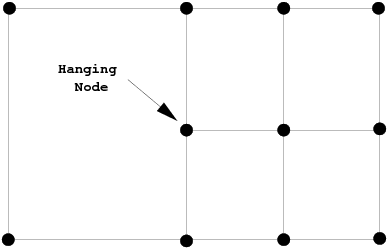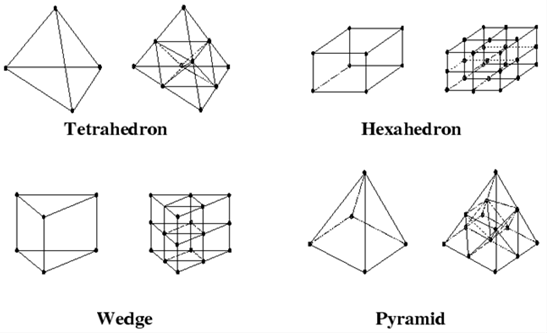Hanging node adaption is used for 2D meshes, and can be selected for 3D meshes. The meshes produced by this method are characterized by nodes on edges and faces that are not vertices of all the cells sharing those edges or faces, as shown in Figure 24.1: Example of a Hanging Node.
The hanging node adaption method uses a variety of predefined templates to recursively refine cells in the mesh. As implemented in Ansys Fluent it can refine triangles, quadrilaterals, tetrahedra, hexahedra, wedges, and pyramids, but not polyhedra. It requires additional memory to maintain the hierarchy of mesh refinement levels, which is necessary for the mesh coarsening procedure that recovers the original mesh.
The cells marked for refinement are divided as described here:
A triangle is split into 4 triangles.
A quadrilateral is split into 4 quadrilaterals.
A tetrahedron is split into eight tetrahedra. The subdivision consists of trimming each corner of the tetrahedron, and subdividing the enclosed octahedron by introducing the shortest diagonal.
A hexahedron is split into 8 hexahedra.
A wedge is split into 8 wedges.
A pyramid is split into 6 pyramids and 4 tetrahedra.
Figure 24.2: Hanging Node Adaption of 2D Cell Types and Figure 24.3: Hanging Node Adaption of 3D Cell Types illustrate the division of the supported cell shapes.
To maintain accuracy, neighboring cells are not allowed to differ by more than one level of refinement. This prevents the adaption from producing excessive cell volume variations (reducing truncation error) and ensures that the positions of the parent (original) and child (refined) cell centroids are similar (reducing errors in the flux evaluations).
The mesh can be coarsened after it has been refined, by reintroducing inactive parent cells (uniting the child cells to reclaim the previously subdivided parent cell). An inactive parent cell is reactivated if all its children are marked for coarsening. You can eventually reclaim the original mesh with repeated application of the coarsening. Through this process, it is not possible to coarsen the mesh further than the original mesh.
The hanging node method has the following limitations:
Polyhedra will not be refined when this method is applied.
The hanging nodes in the adapted mesh are incompatible with dynamic layering and remeshing methods.
Face and/or cell zone separation should be done prior to hanging node adaption, otherwise you would need to convert cells with hanging nodes to polyhedra.
Legacy anisotropic or prismatic refinement is not supported for meshes that have undergone hanging node adaption.
Fusing of face zones is not supported for hanging-node adapted meshes.





